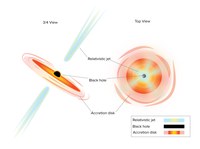Identifying the Source of a High-energy Neutrino
 Previous detections of individual astrophysical sources of neutrinos are limited to the Sun and Supernova 1987A, whereas the origins of the diffuse flux of high-energy cosmic neutrinos remain unidentified. On 22 September 2017, the IceCube Neutrino Observatory sensors, distributed throughout a square kilometer of ice under the South Pole, detected a high-energy neutrino, IceCube-170922A. Its arrival direction was consistent with the location of a γ-ray blazar, TXS 0506+056, observed to be in a flaring state. An extensive multiwavelength campaign followed, ranging from radio frequencies to γ-rays. These observations characterized the variability and energetics of the blazar. This observation of a neutrino in spatial coincidence with a γ-ray–emitting blazar during an active phase suggests that blazars may be a source of high-energy neutrinos. Following the IceCube detection, astronomers looked at TXS 0506+056 with numerous telescopes and found that it had brightened in gamma rays, X-rays, and visible light. Tracking the high-energy neutrino detected by IceCube to TXS 0506+056 marks the first time a specific object has been identified as the probable source of such a high-energy neutrino.
Previous detections of individual astrophysical sources of neutrinos are limited to the Sun and Supernova 1987A, whereas the origins of the diffuse flux of high-energy cosmic neutrinos remain unidentified. On 22 September 2017, the IceCube Neutrino Observatory sensors, distributed throughout a square kilometer of ice under the South Pole, detected a high-energy neutrino, IceCube-170922A. Its arrival direction was consistent with the location of a γ-ray blazar, TXS 0506+056, observed to be in a flaring state. An extensive multiwavelength campaign followed, ranging from radio frequencies to γ-rays. These observations characterized the variability and energetics of the blazar. This observation of a neutrino in spatial coincidence with a γ-ray–emitting blazar during an active phase suggests that blazars may be a source of high-energy neutrinos. Following the IceCube detection, astronomers looked at TXS 0506+056 with numerous telescopes and found that it had brightened in gamma rays, X-rays, and visible light. Tracking the high-energy neutrino detected by IceCube to TXS 0506+056 marks the first time a specific object has been identified as the probable source of such a high-energy neutrino.
The Very Large Array (VLA) observed TXS 0506+056 in several radio bands from 2 to 12 GHz, beginning two weeks after the alert, detecting significant radio flux variability and some spectral variability of this source. The source is also in the long-term blazar monitoring program of the Owens Valley Radio Observatory 40m telescope at 15 GHz. The light curve shows a gradual increase in radio emission during the 18 months preceding the neutrino alert. TXS 0506+056 has also been monitored for years with the Very Long Baseline Array (VLBA). VLBA images have shown bright knots of radio emission that travel outward within the jets at nearly the speed of light. The knots presumably are caused by denser material ejected sporadically through the jet.
Image: A supermassive black hole at the core of a galaxy accelerates particles in jets moving outward at nearly the speed of light. In a blazar, one of these jets is pointed nearly straight at Earth. Credit: Sophia Dagnello, NRAO/AUI/NSF
Publication: The IceCube Collaboration et al., Multimessenger observations of a flaring blazar coincident with high-energy neutrino IceCube-170922A, Science, 361, 146 (No. 6398, 11 July 2018).




Connect with NRAO